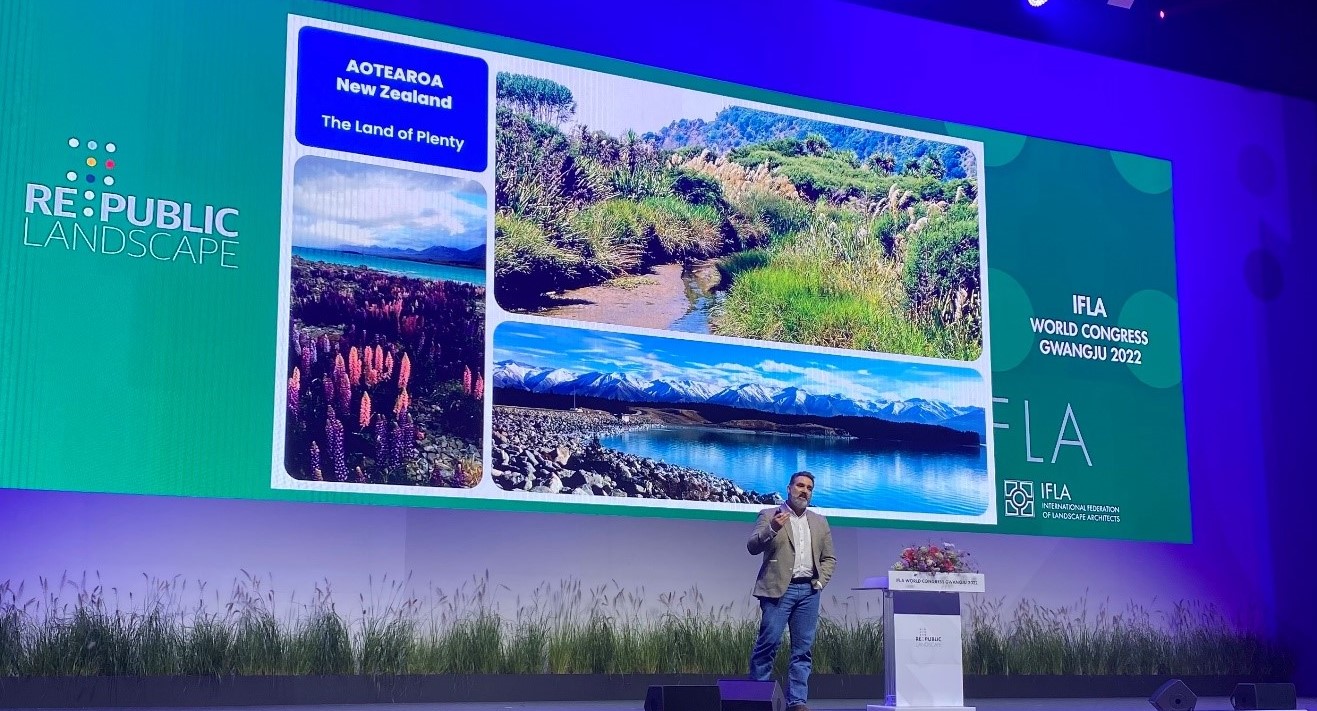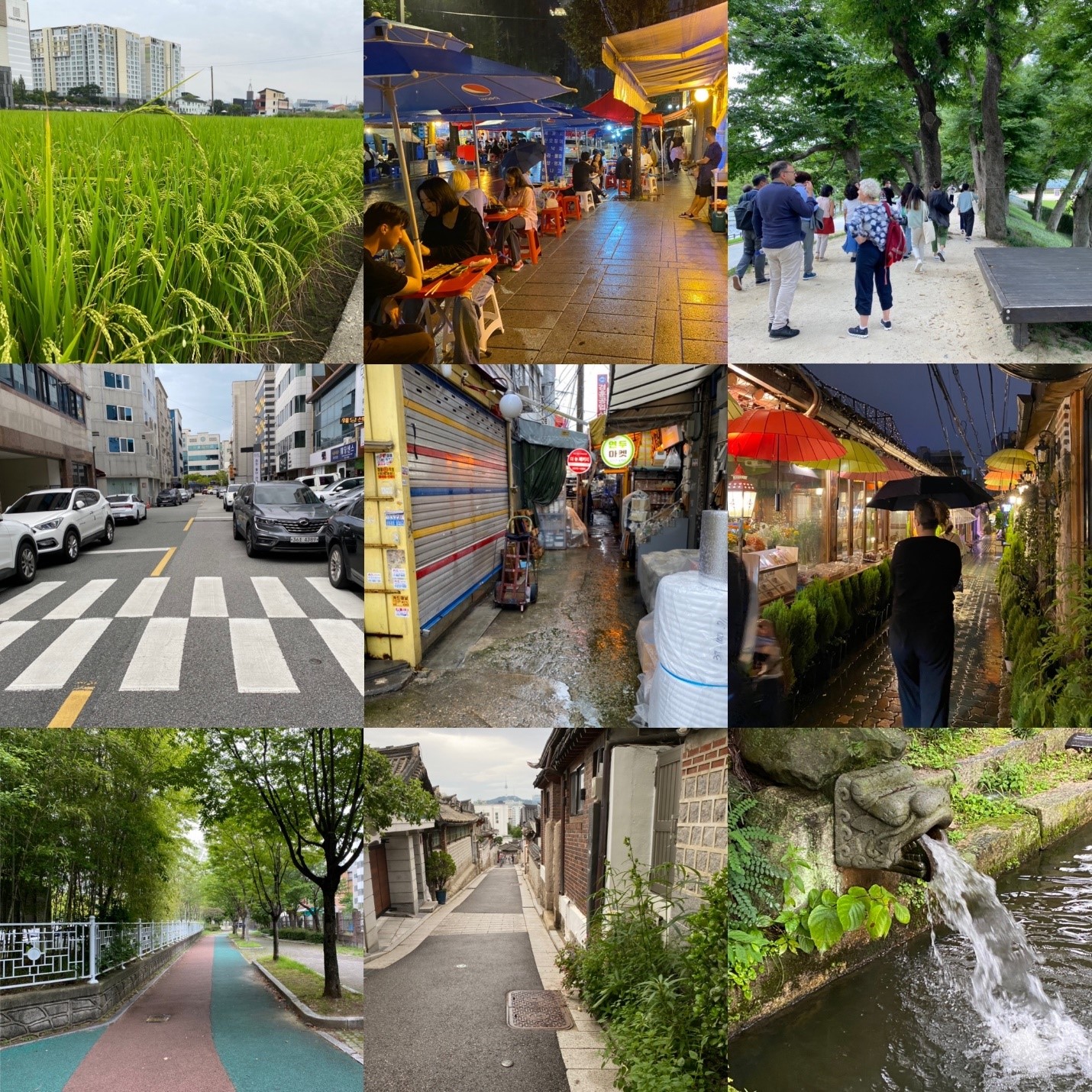In September, Craig Pocock - Principal Landscape Architect at Beca, delivered a keynote address on his pioneering Carbon Landscape work to the 58th International Federation of Landscape Architects (IFLA) World Congress Gwangju 2022 in South Korea. Attendees came to learn from one another, contributing to IFLA’s mission to create globally sustainable and balanced living environments around the globe.
In this article, Craig presents his first-hand observations from the Congress, and what he has learned about the Carbon Landscape to date.

Delivering the Carbon Landscape to an international audience on the opening day of the 2022 IFLA World Congress was a real privilege - to represent my profession and New Zealand on the global stage.
More importantly, the opportunity gave mana to an idea that originates out of Aotearoa. The Carbon Landscape not only reflects kaitiaki values unique to Aotearoa, it is also an original idea that is about two decades ahead of its time.
To acknowledge that kaupapa, Aotearoa, and my own place in the world, I started my keynote with my mihi and gave a brief explanation as to why the mihi is important in forming our approach to whenua and design. I am not confident in te reo Māori but wanted to do my best to represent Aotearoa on an international stage.
The presentation sparked three days of conversations with international IFLA leaders around carbon mitigation in our urban environments and city-wide open space networks. I started to understand how far ahead Aotearoa’s Carbon Landscape thinking is compared to the rest of the world. It was both disappointing and exciting: as an international design collective I thought we would be further ahead than we are. And yet, it also gave a clear indication that there is a chance to amplify our thinking, get ahead of the market and for Aotearoa to remain the innovators.
Another keynote speaker thanked me for making the effort to acknowledge a First Nations people and cultural practice. She explained the impacts of past colonisation on South Korea and the ongoing negative impacts of global design practices being applied to Korean landscape design and urban spaces. This became a strong theme of the Congress, addressed in several keynotes.
Having heard about the impacts of colonisation in South Korea (thanks to Keunsik Jeong, Seoul National University and Ah-Yeon Kim, University of Seoul/Studio Terra) and the negative impacts of global design approaches being applied in Asia (thanks to Jillian Walliss, University of Melbourne and Heike Rahmann, RMIT University), I went for a walk. It took me through the city of Gwangju, the surrounding countryside and eventually into the metropolis of Seoul. Along the way I wondered why New Zealand tends to look to the West for design inspiration and not the East?
As I walked, I noticed:
- A busy inner-city business and entertainment district in Gwangju that had no sidewalks, and pedestrians sharing the street space with cars - and it worked!
- Agricultural landscapes framing the city edge, contributing to a green city image and strengthening a unique sense of place.
- Mega-residential city blocks 500m by 500m square, divided by a grid of green laneways for people and cyclists only.
- A river stopbank with 400-hundred-year-old trees growing on it, creating a wonderful shaded linear park connecting a larger open space network.
- Aesthetically stunning landscapes that integrated public space, movement, water and cultural values in design - developed centuries before we had landscape architecture in Aotearoa.
- Narrow carless laneways in the Hanok villages in Seoul that supported healthy, lively residential communities.
- Vibrant 1.2m-1.8m wide laneways that supported busy restaurants, shops and bars but did not have space for service vehicles. There was just enough space for pedestrians walking and enjoying the sights and sounds.
Would these design outcomes work in New Zealand? Many people might say no. However, if we acknowledge our Western perspective and unconscious professional bias and leave them at the door, we can make the most of the opportunity to listen, observe, and apply critical thinking.

Here are three further observations from the Congress:
Carbon
New Zealand is significantly ahead of the carbon mitigation kaupapa, not just in terms of carbon calculations but understanding where carbon cost sits within all our diverse environments. The following days of international design presentations (that I managed to see) didn’t reference carbon reduction, mitigation or offsetting, which was ironic considering the super typhoon that was in the East China Sea heading towards South Korea at the time. There is still a long way to go but there is an opportunity for New Zealand to continue to lead and innovate in this carbon mitigation space.
Culture
The globalisation of design as well as Western ideals being applied to Asian landscapes, undermines their unique heritage, culture, and sense of place. This is an issue not only in Korea but many countries around the world. I didn’t see any projects at the Congress that acknowledged First Nations engagement in a landscape project or how a design reflected First Nations’ values or aspirations. There is clearly a significant gap in international design thinking to be addressed.
Aotearoa is significantly ahead in terms of cultural integration in landscape architecture. New Zealand has committed to this kaupapa for the last decade, and we are still on our journey. However, considering the damage that design globalisation is doing across cultural landscapes internationally, perhaps we have a responsibility to share our learnings.
Influence
In Aotearoa New Zealand we tend to consider best practice from a Western lens: that the Dutch understand cycling the best and that the Americans create inspiring urban spaces, for example.
This Western-centric thinking limits us and our communities. Why do we not look to the East, Africa and South America for design insight?
The more uncomfortable question might be, are we still in a colonisation loop driven by global design standards and approaches being adopted without culturally critical thinking? Are we willing to decolonise our design thinking and create an Aotearoa design language and standards unique to us but informed by more than a Western ideal?
An international congress takes you out of national and professional silos and exposes you to new ideas. These new environments provide living examples for different ways of thinking that could be adapted to benefit our communities. There is value in seeing a 400 year-old river stopbank that was built by hand and planted with trees, fulfilling both an engineering and community role. There is value in understanding that a lot of urban life that can happen in a 1.2m-wide laneway.
The experience was a window into understanding what Aotearoa New Zealand does really well and where we are ahead of the design curve, and consider where New Zealand could bring innovation to the market.
Craig Pocock
Principal - Landscape Architecture
 New Zealand
New Zealand
 Australia
Australia
 Singapore
Singapore